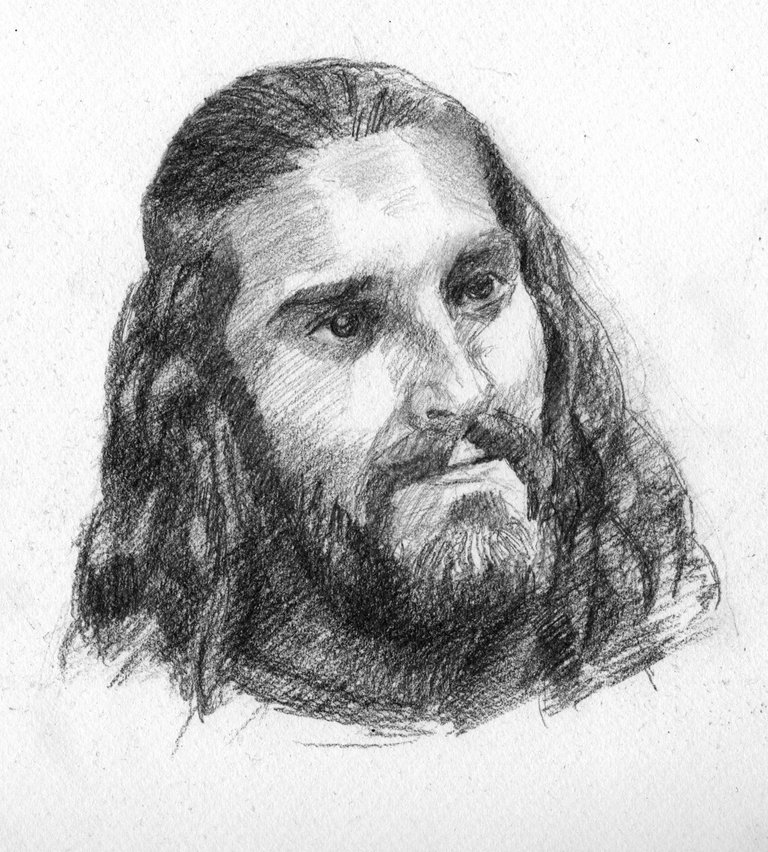Monday Sketch - Vlad the Impaler

I came across a Netflix series, "Rise of Empires: Ottoman". One of the historical figures they bring to life is Vlad the Impaler, who took on the might of the Ottoman empire, waging a bloody war against them. His vengeful reprisals and gruesome punishments are what led him to being the inspiration for Dracula.
Many think the use of impaling criminals or enemies was his own sadistic idea, rather he was meting out the same punishments that the Ottomans themselves dealt.
Something that immediately leapt out to me, was how much the actor playing Vlad, looks like the one who plays Nando the Relentless from the vampire spoof series, "What We Do in the Dark".
I've started watching "Rise of Empires: Ottoman", so far the story has been focused on the fall of Constantinople and has not made it to Vlad yet. The costuming is a bit garbage, as sadly many modern historical productions are today, which given the amount of research there is available these days, makes it inexcusable.
Often the real fashion, culture and architecture of the past was far grander and more interesting than what the film or TV productions present to us.
Nevertheless, I'm filling in a gap in my knowledge with regards to the fateful fall of Constantinople which had so much impact upon the rest of Europe.
Leave a comment below, upvote and share if you like it.
More of my artwork can be found on my website. LeoPlaw.com
Wanting to have an original artwork, take a look at this list.
And if it takes your fancy, subscribe to my newsletter.
I'm available for lessons and mentoring.

Looks like Jesus, lol.
Maybe check this article https://www.derstandard.de/story/2000141703142/wer-war-vlad-dracula-forscherpaar-macht-sich-mit-neuer-methode
or that here: https://www.britannica.com/biography/Vlad-the-Impaler
btw - the 'famous' painting they always show hangs at the castle Forchtenstein in Austria: https://esterhazy.at/burg-forchtenstein - I seen it there many years ago in person. The connection of the Esterhazy family is that they are related.
There are some links that may prove fruitful about the East Roman Empire on this Wikipedia article: https://en.wikipedia.org/wiki/Byzantine_Empire
or if you don't trust Wikipedia, check this one: https://www.britannica.com/place/Byzantine-Empire
and when all else fails, go to Istanbul yourself and ask Erdogan.
If you are in the research mood, in Austria there is also the castle Lockenhaus where you can find inspiration about another monster, Die Geheimnisse der Blutgräfin Elisabeth Báthory: https://www.ritterburg.at/burg/geschichte
Es gibt Führungen in der Burg Lockenhaus, über die Blutgräfin ebenso auch über Dracula:
https://www.ritterburg.at/erlebnisse/fuehrungen
The Austro-Hungary history is deeply connected to these, as Dracula's home province (now in Romania) was once called Siebenbürgen and was part of Hungary.
Seems both Vlad the Impaler and Elizabeth of Bathory were inspirations for Dracula.
both the castles Lockenhaus and Forchtenstein have special presentations on that subject. The Austrian province of Burgenland was once part of Hungary, and further back in history, Hungary was part of the Austrian Empire, and Hungary extended over the greatest parts of todays Romania, where Dracula originated. Transilvania was called Siebenbürgen at that time and had a sizable population of German origin (even to this day).
I seem to recall some TV show covering her story. I believe they bricked her up in a cell in the end when they found out what she was doing.
Forchtenstein Dracula:
more about Forchtenstein: https://www.vienna-unwrapped.com/forchtenstein-castle/
How I wish I could understand this video.... I'm decoding with the pictorial view, I'll try to check this later
Seems there are no automatic subtitles for this video.
Damn, we almost visited burg Forchenstein last year, but went to the Esterhazy palace instead, and thus miss out on meeting Vlad.
btw, Leo, you say the costumes in this Netflix series are not authentic - so what makes you think their history is? If you must learn about it, go as close to the sources as you can.
Actually, while watching the series, I was doing research. They're pretty spot on with what happened. The only thing is inflated female roles in the story and the love interests to dramatise it. Otherwise they've covered the story well.
I've just never taken the time to look into the details of that event in history, until now.
But history is like that. It's a huge jigsaw puzzle; you can only put it together piece by piece.
Amazing